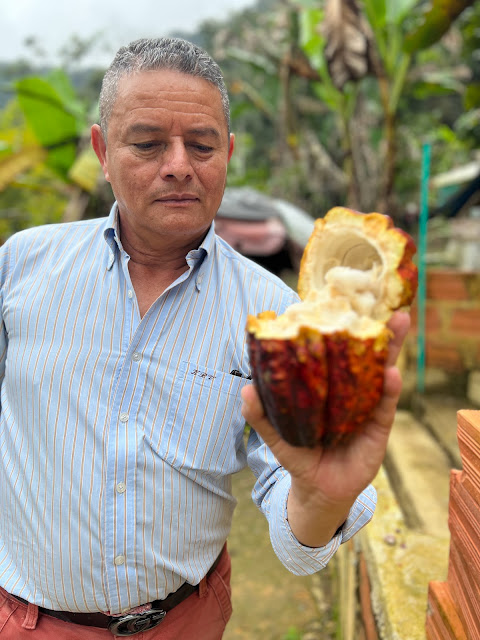Five Marketing Lessons from Working with Cacao Producers in Colombia
By Tasha Prados
After fifty years of violence, many farmers in Colombia were trapped growing illicit crops—the coca used to make cocaine. In 2014, one farmer in Otanche realized he needed a change. Don Pedro ripped out all the coca from his land and planted cacao (the seed used to make chocolate). It was a risky move: it takes 30 months for cacao to mature. As Don Pedro and others grew their cacao production, they formed the Cooperativa Integral de Productores Agropecuarios de Otanche (Cipaotanche). Now, nearly a decade later, the Cipaotanche cacao association has 70 members and produces bean-to-bar Quincha chocolate.
When Partners of the Americas reached out to me to support Cipaotanche with their marketing strategy via the USAID Farmer-to-Farmer program, I was skeptical. I was doubtful that two weeks was enough to generate impact, and I was sure that there were Colombian marketing specialists who were also well positioned to support Cipaotanche.
However, I was excited to lend my expertise and felt that my experience could match the needs of Cipaotanche. I am a bilingual and multicultural branding and marketing strategy consultant; I founded Duraca Strategic so that I could help social enterprises maximize their impact. My brand values include giving back, so this felt like a perfect opportunity. I started my career in international development and have lived, worked, and volunteered in many Latin American countries. As a digital nomad and founder of Duraca Travels, I’m always up for an authentic travel experience.
I loved learning about the cacao value chain from Cipaotanche and was stunned as they demonstrated the level of work to produce just one bar of chocolate. It was fulfilling to support them in developing a marketing strategy to better position their products and increase sales.
Here are 5 timeless lessons that I shared with Cipaotanche for their marketing strategy. These lessons can serve any social impact organization.
1.
Hone in on your
perfect-match target audience. Your perfect
target audience is the one who is ready to buy what you’re offering—and looking
for it. It’s not someone you need to educate or convince about the value of
your product. In Colombia, the kind of high-value cacao and single-origin
chocolate that Cipaotanche produces is not yet consumed by many Colombians. So,
we knew their most ready audience would be expats, foreigners, and tourists –
and the businesses that sell similar luxury consumables to them. We also talked
about leading the charge in introducing this kind of chocolate to the Colombian
market.
2.
Double down on what’s
working.
To grow your business, you need to understand where your leads come
from.
You need to understand when, where, and how people are buying what you offer –
and why. Once you understand what’s working well, do more of it. We captured Cipaotanche’s
sales data for the first time. We examined the trends in their sales, and strategized
how to do more of what was working well. For example, we found that various companies
enjoyed giving Cipaotanche’s Quincha Chocolate as gifts to their employees. Cipaotanche
could leverage this connection and expand their market reach by asking existing
clients to refer their products to other companies.
3.
Be where your clients are
when they are thinking about what you offer. Don’t just think about who your target
audience is – think about where they are when they want what
you’re offering. We talked about reaching out to food tours, souvenir shops,
luxury goods grocery stores, restaurants, bakeries, and high-end coffee stores
to increase the visibility of Cipaotanche’s products.
4.
Share your story. Its important to
share your origin story and brand values, and create key messages that aren’t just about
sales. Your customers will have a much stronger relationship with your brand if
you connect with them on something greater than just the sale of your product.
This best practice will help you stand out from your
competitors.
Cipaotanche has many brand values that clients could identify with: environmental
stewardship, community capacity building, youth and women participation, productive
and licit livelihoods, as well as farmer agency and access to a fair and
reliable market price.
5. Leverage your strengths. It’s easy as entrepreneurs to focus on how much you still need to do. Don’t lose sight of all the things you have going for your business already. In Cipaotanche’s case, they have a lot: a strong community & leader, a solid brand, good packaging, a website, existing clients, and many strategic alliances. That’s a lot to build from!
You can see what my time with Cipaotanche was like here.
Tasha
Prados is an award-winning branding & marketing strategy consultant, travel
writer, and digital nomad creator. She
is the founder of Duraca Strategic, where she
helps purpose-driven entrepreneurs and organizations maximize their impact, as
well as Duraca Travels, for living your
best digital nomad life. Get business strategy tips from Tasha at @duraca.strategic and travel tips at @t.prad.





.png)

Comments
Post a Comment